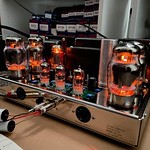If so what are your interpretations of what you are hearing as compared to running only tubes?
Thanks
Last edited by bluemeanies on Thu Feb 04, 2016 7:05 pm; edited 1 time in total

Dedicated to the restoration and preservation of all original Dynaco tube audio equipment - Customer support for Tubes4hifi VTA tube amp and preamp kits and all Dynakitparts.com products
 Tubes &Solid State
Tubes &Solid State Re: Tubes &Solid State
Re: Tubes &Solid State
 Re: Tubes &Solid State
Re: Tubes &Solid State Re: Tubes &Solid State
Re: Tubes &Solid State Re: Tubes &Solid State
Re: Tubes &Solid State
 Re: Tubes &Solid State
Re: Tubes &Solid StateTube Nube wrote:
I guess you could say I'm bi amping. St 70 to my main speakers, and I have powered sub woofers with solid state plate amps built in.
At those low frequencies, many of the problems associated with solid state are not audible, due to our hearing not being so sensitive to details in that frequency range.
 Re: Tubes &Solid State
Re: Tubes &Solid State Re: Tubes &Solid State
Re: Tubes &Solid State Re: Tubes &Solid State
Re: Tubes &Solid State
 Re: Tubes &Solid State
Re: Tubes &Solid State Re: Tubes &Solid State
Re: Tubes &Solid Statej4570 wrote:In Car audio (I used to do install in the 1980's, and yes I built some "bass" boxes), we nearly always used an electric crossover from the bass (woofers, somewhere 80-120 Hz, I liked 80), to the mid/tweets. My setup had passive crossovers for the midrange/tweeter splitting but I knew people that used 3 way crossovers as well. This was usually done not to lighten the frequency load, but apply the largest amp to woofers which were in the trunk and then the rest of the power could come from a 4 channel amp or 2 two channel amps. It was more of an electrical demand issue. These large systems taxed alternators of the time, we even installed large capacitors on the 12V inputs (.1 to 1 Farad) or distribution block leading to the amps. With 12V supplying power for the amps, it was not uncommon to use 4 gauge wire from the battery to distribution block.
This is one area I would not have wanted to have a tube amp.......
Of course I have none of that now.
Jason
 Re: Tubes &Solid State
Re: Tubes &Solid StateDavid, in a sense, yes. The upper-end Vandies have an external electronic xover between the preamp and amps which has DIP switches to select the input impedance of the power amps and is powered by a soldered-in 9-volt battery. When the signal gets to the speaks another 9-volt cross-over separates the high and low and sends the low to the subwoofer module powered by an AB solid-state amp, and why Richard strongly suggests bi-wiring.Tube Nube wrote:Say Dave, did you use electronic cross over(s) ahead of the power amps so as to lighten the frequency range load each amp was dealing with?
 Re: Tubes &Solid State
Re: Tubes &Solid Statedeepee99 wrote:
For you car-installer guys, what was that gizmo that turned the car's DC into AC to run the tube radio in my old 1947 Chev? I want to say vibrator, but that would probably offend the PC crowd amongst us.
 Re: Tubes &Solid State
Re: Tubes &Solid StateWay cool! I still remember that buzz when the radio was warming up. But it sure worked. I had the reverse of such a gizmo on one of my boats that converted 32VDC to 110VAC. The 32DC-volt bank powered a motor that was physically connected to a 110v alternator. Didn't put out a lot but enough to run a TV or a vacuum cleaner, albeit not at the same time.daveshel wrote:deepee99 wrote:
For you car-installer guys, what was that gizmo that turned the car's DC into AC to run the tube radio in my old 1947 Chev? I want to say vibrator, but that would probably offend the PC crowd amongst us.
You're exactly right, Dave - the vibrator power supply. I actually met the man who invented it. In the 1980s he was retired and lived in Naples, Florida, where my grandfather lived. Grandpa introduced me to him on the golf course.

 Re: Tubes &Solid State
Re: Tubes &Solid State Tubes &Solid State
Tubes &Solid State
 Re: Tubes &Solid State
Re: Tubes &Solid State
 Re: Tubes &Solid State
Re: Tubes &Solid State
 Re: Tubes &Solid State
Re: Tubes &Solid Statedaveshel wrote:Not to change the subject (again), but I've always wondered what role a servo could play in an amplifier. Seems like it's a mechanical device in an electronic milieu.
 Re: Tubes &Solid State
Re: Tubes &Solid Statecorndog71 wrote:
Here's the source of the technology. http://www.rythmikaudio.com/index.html
I use 2 of the GR Research F12 16 Ohm subs with custom matched A370PEQ servo amp. These can be ordered from Danny at http://www.gr-research.com/ (minus cabinets).
 Re: Tubes &Solid State
Re: Tubes &Solid Statedaveshel wrote:corndog71 wrote:
Here's the source of the technology. http://www.rythmikaudio.com/index.html
I use 2 of the GR Research F12 16 Ohm subs with custom matched A370PEQ servo amp. These can be ordered from Danny at http://www.gr-research.com/ (minus cabinets).
Very interesting. I'd like to hear that.
 Re: Tubes &Solid State
Re: Tubes &Solid State Re: Tubes &Solid State
Re: Tubes &Solid State Re: Tubes &Solid State
Re: Tubes &Solid State